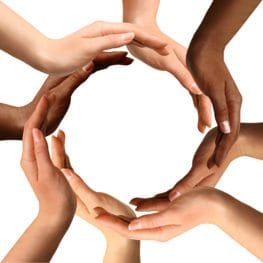DAVIDSON HISTORY
Questioning Normal

1975 photo captures ideal of shared space; 40 years later, it’s still a work in progress. (photo courtesy of Davidson College Archives)
This is a different kind of history column. It grew out of a recent student initiative at Davidson College, tours that reframed history taking into focus race relations. I was quoted in a related article saying “There’s still a sense on this campus that the normal audience is white, and everyone else is invited onto campus as a guest, not as the norm.” In response to questions about the context and history behind that quote, I wrote the following based on experiences at Davidson as well as at 3 other colleges and universities.
Thank you for your questions. I’m happy to give more context to that quote. It was not a reference to superiority or overt racism but about the effects of being “other.”
We started the interview with my memories of coming of age in a time when women were actively entering professions, becoming lawyers, doctors, ministers, etc. The convention of the time was to use the word “doctor” for men and woman doctor, woman lawyer, woman minister for women. The inference was that real doctors, normal doctors were men and women were “other,” perhaps just a passing trend, perhaps not quite normal. Four decades later, our cultural imagination has expanded to the point that the qualifiers are gone. Doctor encompasses both men and women. Law firms have women as partners as a matter of course.
In the college context, imagine being a Jewish student and finding out that every big campus celebration includes pork BBQ. You are a fully welcomed student but since normal Davidson students eat pork, you find yourself not quite normal, something other. College celebrations hold up a mirror of the community that you cannot see yourself in. No one intends to say you are inferior, just other.
Or imagine a college store that sells makeup for white complexions but not black. The message is women students are expected to be white, that’s the norm. It’s not saying whites are superior, but it does name blacks as other.
 Or imagine a curriculum where American literature classes focus on white writers (mostly male) and African-American or Latino authors are segregated into separate classes. Another message that real American writers are white (and male), while everyone else is “other.” Not specifically inferior but not the norm.
Or imagine a curriculum where American literature classes focus on white writers (mostly male) and African-American or Latino authors are segregated into separate classes. Another message that real American writers are white (and male), while everyone else is “other.” Not specifically inferior but not the norm.
Or imagine white students fully comfortable with historically all-white fraternities who genuinely welcome students of color but who are also discomfited by the presence of historically black fraternities and the genuine invitations to join those groups. Why aren’t both scenarios okay? It’s not about feeling superior, but about being caught in our sense of what is normal.
This can happen with the kinds of speakers and performers brought to campus, choice of movies shown in the union, even TV programs in dorm lounges. It’s how many cultures are represented within the overall culture. Davidson College has worked to shift this definition of normal but there are still legacies to address.
As a white woman, I too, have not felt superior and have tried to treat folks with equality but I’ve also learned that whether I asked for it or not, whether I want it or not, I have privileges that come with being white. I can move across campus easily, can be listened to, have authority. The current normal (of Davidson as a predominately white space) is deeply embedded and hard to see. It takes practice and work to question it.
Going back to dinner imagery, Davidson is trying to move from a white space where whites host others as welcome guests to a shared space where whites are not superior or inferior, not more or less privileged, but simply fellow guests, equal to everyone else. (If you’re wondering who is hosting, let’s say it’s a collaborative effort or very well-organized potluck.) It is my lived experience and what I have learned from conversations with students, staff and faculty of color and white that we are not there yet.
If you’re wondering what we as individuals can do about it, imagine me in a store looking at magazines. I see Ebony and Essence but say, they aren’t my culture, not part of my tribe. I’ll stick to Southern Living and Glamour. Or I can say, I want to be part of a bigger tribe, one that includes people who read Ebony and people who read Southern Living. I can change what I read and my normal to embrace a wider culture. Cultural normal are not engraved in stone, they are fluid and we can change them.
Jan Blodgett
Jan Blodgett moved to Davidson in 1994. In 2017, she retired after 23 years as the Davidson College Archivist. Jan and former Davidson College history professor, Ralph Levering, are the co-authors of "One Town, Many Voices: A history of Davidson, North Carolina."


